gender typing
the process by which children acquire the values, motive, and behaviors considered appropriate for their gender in their particular culture
Definition of Sex
- the genetic/biological component of femaleness/maleness
- what you are born with
definition of gender
- behavioral, cultural, and psychological components of femaleness/maleness
- how you feel/present yourself
gender-based belief
an idea that differentiates males and females
gender identity
identifying and accepting the self as male or female
perception of yourself
gender role stereotypes
- cultural beliefs about behaviors/attributes associated with each sex
- what is typical/appropriate for a specific sex
gender-role preference
desire to possess certain gender-typed characteristics
gender-typed behavior
- gender "appropriateness" of own behavior
- acting on what is appropriate for your sex
gender/sex differences in abilities, behavior, etc.
- differences are reliable but very small
- more of these things are overlapping than is different
–Verbal Ability (F>M)
–Emotional Expressivity (F>M)
–Compliance (F>M)
–Visual/Spatial Ability (M>F)
–Mathematical Reasoning (M>F)
–Self-Esteem (M>F)
–Developmental disorders (M>F)
–Aggression (M>F)
–Activity Level & Risk Taking (M>F)
–Friend group size (M>F)
evolutionary take on gender/sex differences
- males and females need different strategies to enhance their chances of reproducing and advancing natural selection
- adaptive behaviors passed down through genes (sex differences were on all chromosomes of certain genes)
- Ex. Women had to thoroughly communicate about plants while gathering, but men needed to only communicate briefly during hunting so that they would not put themselves into danger
- Men: prefer younger and more attractive mates to produce a healthy child
- Women: needed a man who can provide since she would be stuck home with the kids
gender stereotype
belief that members of a culture hold about acceptable and appropriate attitudes, interests, activities, psychological traits, social relationships, occupations, and physical appearance for males and females
gender roles definition
composite of the behaviors actually exhibited by a typical male or female in a given culture
the reflection of gender stereotype in everyday life
gender stability/constancy
- stability- the fact that males remain male and females remain female
- constancy- the awareness that superficial alterations on appearance or activity do not alter gender
gender-typed toy preferences
- as young as age 1.5 children prefer to play with toys that are traditional for their gender
- in a study that let boys and girls play with any toys they wanted, boys had a large preference for masculine toys, girls had preference for feminine toys, but played with toys of both types
- when that study was replicated with monkeys they same results were found (eliminates cultural/social influences)
gender schema theory
- how children process information about gender into a coherent whole from the child's own perspective and from cultural experiences and expectations
- children can pick out what is consistent about gender and how they process information about gender which impacts gender related behavior
- ex. When toys are labeled related to a specific gender, children with strong gender schemas will not play with toys inconsistent with their schema (a girl with a strong gender schema will not play with a toy marked “masculine”)
- not mutually exclusive to social cognitive theory
Social Cognitive Theory of gender development
- Children learn through observation and getting feedback from their environment
- Observes other kids and adults of both genders
- More aimed at modeling information
- not mutually exclusive to gender schema theory
social structural theory of gender roles
an explanation of gender roles that focuses on factors such as institutionalized constraints on male and female opportunities
role of parents in gender development
- differential treatment and perceptions at birth (parents fill children's rooms with toys, clothes, etc. that are often gender specific)
- parents are more verbal with girls, harsher with boys, fathers have preferences for sons, mothers treat children more similarly
- encouragement and reinforcement of gender-typed behavior
- more tolerance for girls breaking gender stereotypes than boys
- modeling: parents who are more masculine/feminine have children who are more masculine/feminine
- gender neutral stereotype
parental encouragement and reinforcement of gender-typed behavior
- play- rewards for playing with gender-typed toys, toys are reinforcing gender by purchasing gender-typed toys
- independence- encourage boys to explore more than girls and take more risks
- achievement- encourage more competition in boys than girls in academics and sports
gender neutral stereotype
parents keep the gender of the child secret for the first few years of life so that neither gender is emphasized
sources of gender socialization
- peers- peers criticize other peers for violating stereotypes (boys criticize more, girls tend to ignore people who break stereotypes)
- media- both genders seek out consistent content on tv which promotes gender-typed behavior
- teachers- some teachers emphasize gender types more than others and teacher emphasis does make a difference in attitudes, teachers help boys more in math and science than girls
types of gender roles
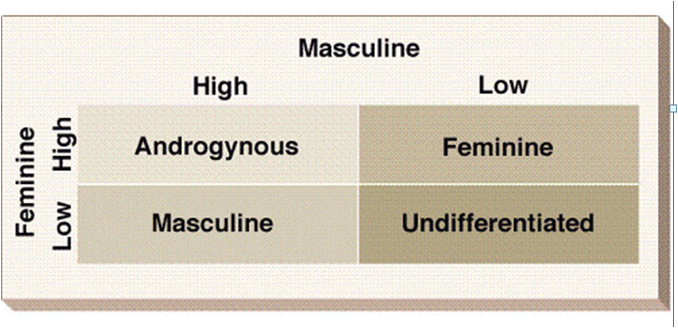
- positive benefits of androgyny- well adjusted, well liked, positive well being, more behavioral flexibility, particularly true if you're confident in your gender orientation
- social expectation- masculine males make more money in the same job as less masculine males
transgender development
- Sometimes individuals do not adopt the gender identity of their biological sex
- Feel “trapped in the wrong body”
- Often, societal reactions involve shock, anger, and concern.
expressive characteristics
those aspects of a person involving nurturance and concern with feelings
more typical of females
instrumental characteristics
those aspects of a person involving task and occupation orientation
more typical of males
categories of theoretical approaches to moral development
- Cognitive theories: (reasoning)
–How do people think about what is right and what is wrong?
- Biological/evolutionary theories: (emotions)
–What innate traits or characteristics are we born with that facilitate the development of morality?
- Socialization theories: (behavior)
–How do parents and other authority figures teach children social rules?
3 approaches of cognitive theories of morality
piaget
kohlberg
social domain theory
piaget theory of moral development
- Premoral–0-5 years; no concern for rules
- Moral realism / Heteronomous stage–5-11 years; obey authority to avoid punishment; think of rules as unchangeable; immanent justice
- Moral reciprocity/autonomous stage–11+ years; based on recognizing social rules are arbitrary and multiple views should be considered; authorities can be questioned
- stages are aligned with cognitive development (moral development is part of cognitive development)
- used interviews to determine stages
immanent justice
disobeying rules will certainly result in punishment
limits of Piaget's stages of moral development
- Underestimated children's abilities (especially young children under 5)
- Young children can consider other people’s viewpoints
- Problems with stage theories- discontinuous development, unidirectional, all kids pass the stages in at the same ages
kohlberg's approach to moral development
- very cognitive focus, stage-like fashion
- Used interviews (like piaget) but gave children moral dilemmas (Heinz Dilemma)
- Asked children what the person in the dilemma would do and why (why is more important)
Kohlberg's stages
- Level I: Preconventional–Based on avoiding punishment or gaining reward; not yet on rules or norms
- Level 2: Conventional–Apply standards set by others, conforming to societal traditions
- Level 3: Postconventional–Individual code of ethics, independent of others’ approval; knowing there are many courses of action and evaluating each option
limits of Kohlber's stages
- not everyone makes it to the last stage, but Kohlberg made it seem like everyone should (implies people who don't make it to the last stage have deficits)
- limits:
- lack of universality- levels of moral reasoning vary across cultures
- Gender bias- Gilligan (should consider care in concern for others part of moral reasoning since women do that more (men generally fall into the higher stages of reasoning))- not supported by newer research
- dilemmas do not mirror real life
Social Domain Theory
Moral, Societal, and Psychological domains develop in parallel
- moral- right and wrong with little ambiguity
- Societal/social conventional domain- knowledge and judgements related to traditions and social rules, varies across cultures
- psychological- only affects self, issues of privacy, issues with immediate physical harm and safety consequences (prudential issues)
findings of social domain theory
- Moral issues:–More generalizable, unalterable, independent of authority, More serious and more deserving of punishment
- Conventional issues:–More context-specific, changeable, dependent on authority
- Personal issues:–Important for self and identity, ok to disobey
- children understand moral issues are more serious than societal issues
social domain theory strength and limitations
–Understands that judgments are made in different domains and that they coexist
–Recognizes that concepts become more complex and differentiate with age (agrees with former theorists)
-- Judgment-Action Gap
judgement-action gap
- there is a gap between moral judgement and moral behavior
- they don't always correlate
- particularly for younger kids
biology of morality
- moral emotions serve the purpose of cooperating with others to lead to the survival of the species
- guilt (Moral behavior), shame (risk taking, delinquency), empathy (prosocial behavior), sympathy and personal distress emerge early
self-regulation
inhibit impulses and behave in accordance with social and moral rules in the absence of external control
internalization
making an effort to control a behavior even when it requires postponing pleasurable outcomes
parental socialization
high moral affect and low parental regulation leads to moral inhibition
social responsibility
prosocial value orientation, rooted in democratic relationships with others and moral principles of care and justice, that motivates a range of civic actions
Shalom Schwartz's model of values
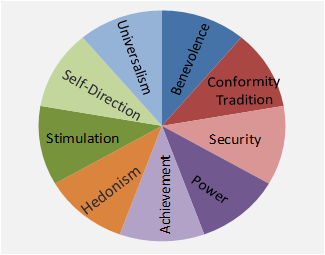
- self-transcendence: helping the broad community (universalism), helping your more immediate community (benevolence)
- vs. self-enhancement: achievement, power, hedonism (maximize net pleasure)
- Openness to change: stimulation (novelty), self-direction, hedonism
- vs. conservation: conformity and tradition, security (safety and health)
- wheel- values closer together are more similar
social responsibility values
- priorities for contributing to the greater good, help others
- benevolence, universalism
- values motivate civic actions/behavior (situational factors may stop people from acting on their values)
key aspects of social responsibility- relationships with others
- certain kinds of relationships encourage social responsibility
- people feel more social responsibility when they feel respected and valued
- only feel connected and concerned for others through interacting with them
key aspects of social responsibility- moral principles of care and justice
- care principles rooted in emotion and concern for others
- justice principles entail cognitive reasoning about fairness and equality (ex. how resources should be allocated)
- best model includes both justice and care
developmental precursors to social responsibility
- emotional development-
- empathy (feeling what other people are feeling), sympathy (understanding what they are feeling)
- emotional regulation- too much distress is an obstacle to prosocial behavior
- cognitive
development
- perspective-taking: need to understand other people's point of view before you can help them
- abstract thinking- must be able to think about abstract concepts
- self and identity development- understanding what is important to you (core content of one's identity)
role of environment in social responsibility development
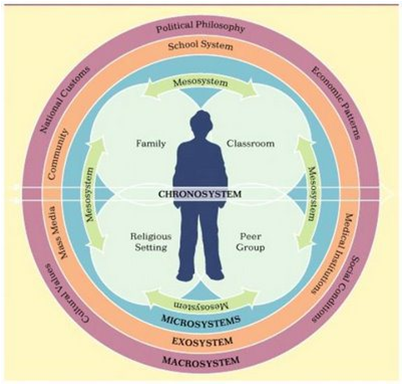
- different layers of content may all facilitate social responsibility development
- focus on microsystem (most immediate environment that the child comes into contact with)
- proximal environment
social responsibility- proximal environmental influences
- modeling behaviors- more respected the person is, the bigger the effect on the child
- value socialization messages- communication about values (parents are primary source)
- opportunities for practice- actions build social responsibility (getting involved)
normative growth hypothesis
social responsibility during adolescence
- increasing social responsibility with age is due to:
- related domains (perspective taking) increasing in adolescence
- identity development consolidation
- increasing autonomy from parents
- interacting with peers and community more
middle adolescence decline
social responsibility during adolescence
- declines in positive psychological constructs (middle school transition, risky behavior)
- U shaped curve in moral reasoning in adolescence
Wray-Lake social responsibility prevention project
- how does social responsibility change with age?
- 4155, 10-18 year olds accessed in 3 waves
- survey to measure adolescent's values of social responsibility
- predicted pattern: supports middle adolescence decline (decline after age 10, upward tick after 17)
- friends (friendships), family
(democratic climate, compassion), school (democratic, belonging,
transitions), and neighborhood (positive climate) were measured
- all declined across adolescence
- limitations: adolescents report (related to their perception of the world), subjective findings
- future directions- causality research
- implications- how contexts are structured and how adolescents receive them is key to their social responsibility
bullying definition
- Unwanted aggressive behavior
- Observed or perceived power imbalance
- Repetition or likelihood of repetition
types of bullying
- Direct- Physical or verbal aggression
- physical- shoving, hitting
- Verbal- name calling
- Indirect- talking about a child behind their back
- relational- damaging or manipulating social relationships
victimization
the process of being threatened or harmed on a constant basis by a more powerful peer
Bias-Based Bullying
- 75% of bullying comes from bias
- bias-based bullying has even more negative impact on health
- biases- sexual orientation, appearance, weight, race (groups that have prejudices against them)
effects of bullying
- lower mental health- increased depression, anxiety, low self esteem (often persist into adulthood)
- lower physical health- increased cortisol (stress hormone), somatic complaints
- lower academic achievement
- some more severely affected than others
potential solutions to bullying
- focus on bully- zero tolerance policy, cognitive behavioral therapy
- focus on parents (more effective in children under
10)
- parent management training (more consistent and clear rules, increased praise)
- talk about bullying with children
- model kindness and respect
- focus on schools- zero tolerance policy, focus on teacher training
aggression definition
- a behavior that causes pain to another person
- behavior, intention, approach
functions of aggression
- proactive- motivated by a desire to achieve a goal, can be premeditated
- reactive- feel threatened, so you react impulsively with aggression
forms of aggression
- physical
- verbal
- relational
aggressive characteristics vs. non aggressive children
- more likely to have:
- aggressive relatives
- irritable and impulsive temperaments
- lower levels of serotonin
- higher levels of testosterone
- prenatal complications
aggression gender differences
- boys are more aggressive than girls overall
- boys think physical aggression is more affective
- seen across social classes and cultures
- higher lying, cheating, and stealing
- differences emerge in toddlerhood
(gender differences are more prevalent around ages 2-3) and persist
into adulthood
- ignoring a child, not inviting them= relational aggression starting in preschool
developmental changes of aggression
- physical -> relational (physical aggression peaks at ages 2-3)
- Proactive -> Reactive (changes in childhood)
- children can plan better to achieve what they want without aggression as they age (prefrontal cortex)
- direct ->indirect (changes in adolescence)
- stable over time overall (certain types of aggression are more prevalent, but rank order stays the same)
early/late starters
- early starters- aggression starts early and often remains throughout childhood and adolescence
- late starters- aggression begins in adolescence and tends to not continue in adulthood
Moffitt and Caspi's Developmental taxonomy
- peak in aggression from 15-20 years old
- persistent 5-6% of people are responsible for 50% of known crimes
- 5% of more aggressive children in childhood have more persistent aggression across the lifespan (life-course)
- more family/parenting risk factors, mother is much younger at birth, more neurocognitive risks, high in behavior/temperament risks
- persistent aggression is identifiable very early in life
- rise in crime rates is due to the adolescence limited group (extra aggression decreases after adolescence)
biopsychosocial model
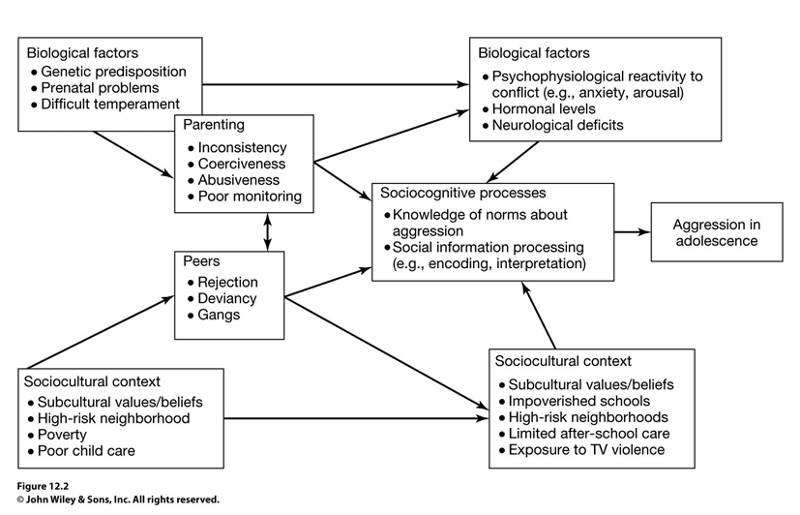
MAOA gene
- deficits in this gene on the X chromosome are related to aggression in humans and animals
- 89% of boys with deficits in MAOA also showed behavioral deficits
- if boys are maltreated and have MAOA deficits they are far more likely to be aggressive than if they were maltreated alone
serotonin
neurotransmitter that regulates endocrine glands, alters attention and emotions, and is linked to aggression
hostile attribution bias
tendency to interpret neutral or ambiguous social behavior of another person as being hostile
deviancy training
amplification of aggression that occurs when adolescents are with and learn from aggressive peers
aggression prevention
- school-based efforts (good behavior game)
- multifaceted approaches are ideal- increase public awareness, involves teachers and parents, develop clear classroom rules
- long-term programs are more effective
social policy
- planned actions to solve a social problem or attain a social
goal
- public policies- designed to create direct services (government based social policy)
- purposes: information, funding, services, infrastructure
Policy making process
- determined by: historical era/social change, money available, federal vs. state governments, research base
- lots of trade-off between different parties interests
types of prevention policies
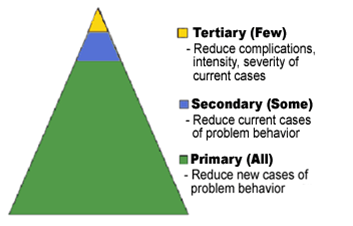
- primary prevention- universal prevention- goal is to reduce new
cases of a problem behavior or illness, prevent it before it happens
- ex. healthy school lunch programs, removing lead paint from toys
- secondary- focused on smaller
population who is already at risk for some kind of a problem,
provide more intensive prevention effort to the most at risk group,
targeted efforts
- ex. food aid, prevent STDs in sexually active teens
- tertiary prevention- treatment
for people who have a problem, waiting until the problem arises (not
prevention)
- counseling for juvenile delinquents
effects of poverty on children
- poor nutrition and health, neighborhood conditions, home environment, parent-child interactions
- leads to problems in: physical health, cognitive abilities, school achievement, socioemotional, problem behaviors, social disadvantages
- decreased child outcomes, less access to quality healthcare, 1/3 more likely to suffer from social and emotional problems, 7x more likely to suffer child abuse
Head Start
- preschool program for 3-4 year olds from poor families, lots of research there
- children there show advanced language development, less aggression, increased mental competencies, parents are more emotionally supportive
- effects are shown to last through 5th grade (better at math and language, better social and emotional skills)
- only reaches about half of those who are eligible and is not quite as good as more expensive preschools
TANF (Temporary Cash Assistance for Need Families)
- provides cash assistance to single parents who are looking for a job and engage in full time work within 2 years
- shown to increase parents employment which is related to the well being of the parents, but does not improve child outcomes or the child's social or psychological development
effects of teen pregnancy
- birth is an obstacle that limits the mother's education- lower earning potential, fewer job opportunities, more economic uncertainty
- more likely to affect families in poverty
- stable relationships with the father improve situations
- 1/3 of moms do well- do better if they have higher academic aspirations to begin with and have supportive well-educated parents
- 2/3 of fathers marry, but 2-3x greater chance of divorce
- children are more likely to die in their first year- prenatal complications, poor health care, less competent parenting
sex education policy
- comprehensive sex education- knowledge about sex facts and safe sex practices
- abstinence only- say no, wait until marriage
- only funding for abstinence only programs
- research shows teens in abstinence only programs only increased sexual activity among teens, but they had sex unsafely because they do not know about safe sex practices
aspects of quality childcare
- Ample physical space
- Ample toys and materials
- Ample staff (high adult: child ratio)
- Caring and responsive caregivers
- Educated caregivers
- Low staff turnover
- Balance of structure and free time
- Accreditation
- Cultural sensitivity / educational philosophy?
types of childcare
- care in one's own home
- family childcare home
- center care- licensed and regulated
pros and cons of childcare
pros
- Children benefit from learning and interacting with peers
- Increased social skills and school readiness
cons
- Time away from family can be detrimental
- Increased stress and assertive/aggressive behavior
potential childcare policies
- Increase availability of high-quality care
- Increase parents’ knowledge of high-quality care
- Subsidize care
- Supplement caregivers’ wages
- Regulate quality
- Limit number of hours children spend in care
- no federal policy on childcare, research is needed